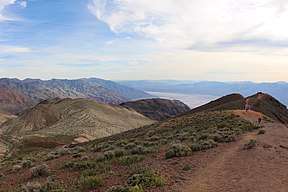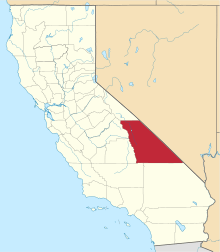Greenwater, California
Greenwater (formerly, Ramsey,[1] The Camp,[1] and Kunze[2]) was an unincorporated community near Death Valley located in the eastern side of the Inyo County, California.[1] It is now a deserted ghost town.
Greenwater | |
|---|---|
Greenwater Location in California  Greenwater Greenwater (the United States) | |
| Coordinates: 36°10′46″N 116°36′59″W | |
| Country | United States |
| State | California |
| County | Inyo County |
| Elevation | 4,288 ft (1,307 m) |
Geography
Greenwater is located 5.5 miles (8.9 km) north of Funeral Peak in the Funeral Mountains above southeastern Death Valley,[2] at an elevation of 4288 feet (1307 m).[1] It is now located within Death Valley National Park, north of Smith Mountain, and south of the Rand, California mining district ruins.
History
Greenwater was a mining town in the Mojave Desert that saw its rise and fall within the first decade of the 20th century.[3] Greenwater's first records date back to the year 1904, these records stated that there were claims that Greenwater dated back to the 1880s however no solid evidence or records were found.[4] Greenwater's geography makes it so that it was difficult to find. Greenwater was newly discovered when a rush of bullfrogs led people to the abandoned town where historians became intrigued by the land.[3]
The original townsite, "Kunze", named after its founder Arthur Kunze was located 2 miles (3.2 km) west of the current site. Kunze was abandoned in favor of the current site, which had the original name of "Ramsey".[2] Greenwater had begun to become more and more operable to the point that a post office was needed and operated at Greenwater from 1906 to 1908.[2]
The rapid rise and fall of a community has not been replicated at any other location. Due to the fact that Greenwater fell almost as soon as it rose, many people believe that it was never a real place to begin with. However, documents and newspapers have proved that it did in fact exist and people did play a role in the community and the companies in Greenwater, CA.[5]

Copper and water
Founded around a copper ore strike in 1905 the town of Greenwater was a short-lived Death Valley community. So dry was its region that water had to be hauled into the town. The lucrative business of water barrel salesman fetched any entrepreneur $15 per barrel; in 1913 that equaled over $250 in 2004 dollars.[6]
Greenwater's many copper mining companies were first mentioned on public records on the 4th of May, 1906. The last mentioned copper company in record books was mentioned on the 1st of September, 1909.[5] The copper companies in Greenwater, CA failed due to the fact that there were so many different companies in such a small area (56 total listed). Of the 56 different Copper companies listed, four were exposed as fraudulent companies.[5] This further points to the failure of the companies, since there was such congestion mixed in with fraudulent leaders, there was a fall in the companies.
Eventually the town grew to 2,000 people and became known for a local magazine, The Death Valley Chuckwalla. The Death Valley Chuckwalla was the magazine which exposed fraudulent companies as stated in the previous paragraph. By 1909 the copper mining had collapsed without ever turning a profit and the residents left town for other areas. Today, there is nothing left of Greenwater.[7]
Uses for the Land
Greenwater, CA is a desert which can have several uses besides the copper mining that the land was previously used for. For example, the land that makes up Greenwater, CA was severely damaged when the town collapsed in the early 1900s which makes it so that there is a mix of soils and sands making the site difficult to build on.[8] The government has had their eye on the land as a possible a camp site, however, the land has not healed itself yet making it so that streets cannot be built. In order for streets to be safe, they must be able to withstand the weight of a tank. Greenwater is made up of a mix of different soils and sands making it unstable. Due to the fact that the sand composition is not secure, a street would not be able to withstand the weight of a tank without collapsing in on itself.[8] Army tanks driving over the land has also permanently damaged the land just as the copper mining had.[8]


References
- U.S. Geological Survey Geographic Names Information System: Greenwater, California
- Durham, David L. (1998). California's Geographic Names: A Gazetteer of Historic and Modern Names of the State. Clovis, Calif.: Word Dancer Press. p. 1168. ISBN 1-884995-14-4.
- http://www.nps.gov/deva/historyculture/death-valley-ghost-towns.ht . accessed 6/22/2010
- Wright, David. "GREENWATER, FURNACE, KUNZE and RAMSEY". GhostTowns. Retrieved March 20, 2019.
- "Section IV: Inventory of Historic Resources--The East Side". December 22, 2003. Retrieved March 28, 2019.
- CPI calculator 1913-2004
- Death Valley Ghost Towns: National Park Service.
- BROWN, KATHRYN. "Ghost Towns Tell Tales of Ecological Boom and Bust." Science, vol. 290, no. 5489, 2000, p. 35. Opposing Viewpoints in Context, http://link.galegroup.com/apps/doc/A66408493/OVIC?u=los53368&sid=OVIC&xid=e68279ba. Accessed 27 April 2019.
